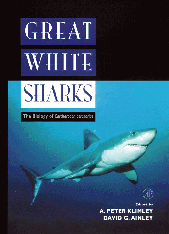| |
This book, published by Academic Press (1996), provides more information about the Great White
than all, but the most obsessed, would want or need. It is the broad scope of this work that draws
out that comment. I would like more on evolution (the Carcharocles argument is not presented) but
this is a soup-to-nuts publication. Some 45 chapters, combining the talents of 67 authors,
are included in eight parts: I Introduction (Chapters 1 & 2),
II Evolution (3 - 8), III Anatomy (9 -10), IV Physiology (11 - 15), V Behavior (16 - 23),
VI Ecology and Distribution (24 - 32), VII Population Biology (33 - 38) and VIII Interactions with
Humans (39 - 45). The bibliography alone spans 20 pages.
Within the Evolution section, the chapters include:
- Chapter 3. Hubbell, Gordon. Using tooth structure to determine the evolutionary history of the
White Shark. pp. 9-18.
- Chapter 4. Applegate, Shelton P., Espinosa-Arrubarrena, Luis. The fossil history of
Carcharodon and its possible ancestor, Cretolamna: a study in tooth
identification. pp. 19-36.
- Chapter 5. Long, Douglas J. & Waggoner, Benjamin M. Evolutionary relationships
of the White Shark: A phyliogeny of Lamniform sharks based on dental morphology. pp 37 - 47.
- Chapter 6. Martin, Andrew P. Systematics of the Laminidae and the origination time of Carcharodon
carcharias inferred from the comparative analysis of mitochondrial DNA sequences.
- Chapter 7. Gottfried, Michael D., Compagno, Leonard J. V., and Bowman, S. Curtis. 1996. Size
and skeletal anatomy of the giant "Megatooth" shark Carcharodon megalodon pp. 55-66.
- Chapter 8. Purdy, Robert W. 1996. Paleoecology of fossil white sharks. pp. 67-78.
Wihin these pages, chapters 3, 4, 7 & 8 all clearly come out in favor of the retention of the genus
Carcharodon for the over-sized great whites that inhabited the Miocene and Pliocene seas The
below bookcover is linked to Academic Press for more details.

|